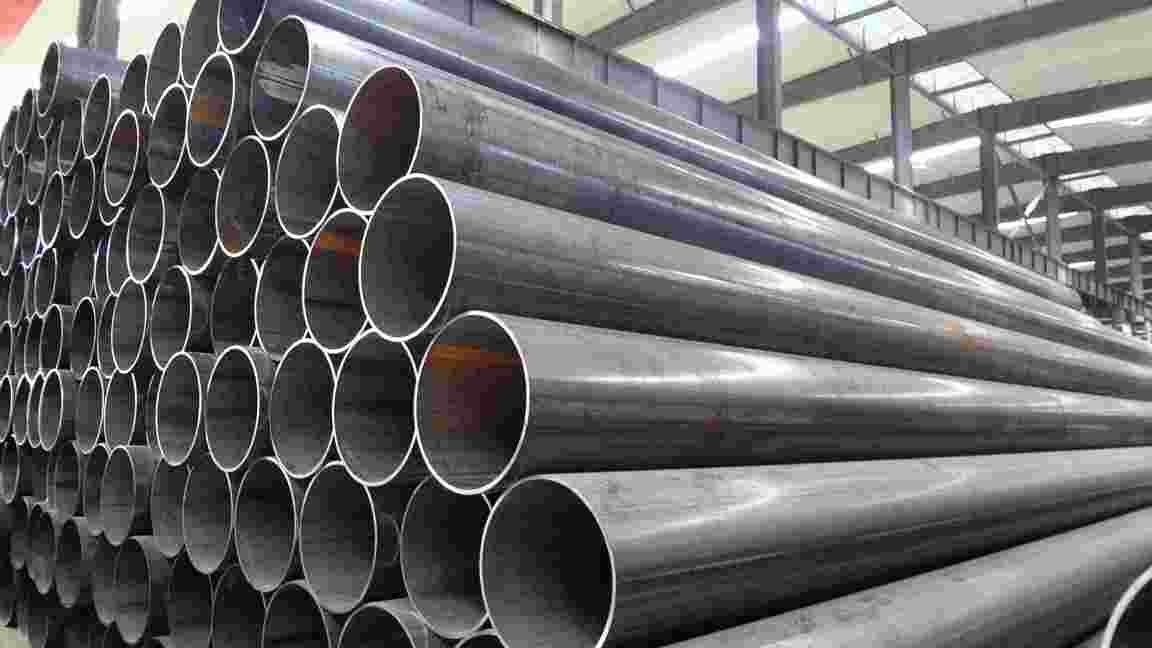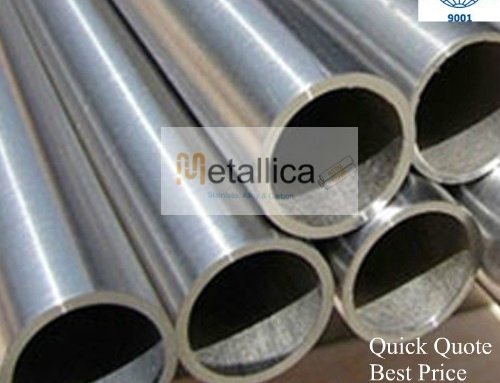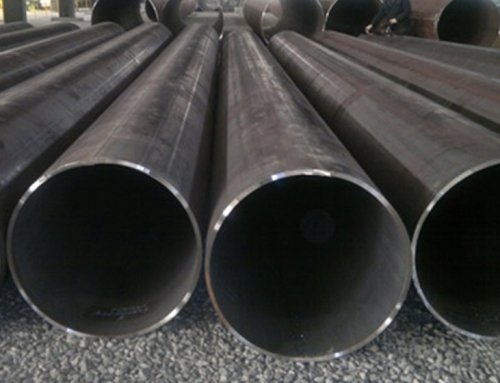Welded Pipes

Welded Pipe
Welded pipe (pipe manufactured with a weld) is a tubular product made out of flat plates, known as skelp that are formed, bent and prepared for welding. The most popular process for large diameter pipe uses a longitudinal seam weld.
Spiral welded pipe is an alternative process, spiral weld construction allows large diameter pipe to be produced from narrower plates or skelp. The defects that occur in spiral welded pipe are mainly those associated with the SAW weld, and are similar in nature to those for longitudinally welded SAW pipe.
Electric Resistance Welded (ERW) and High Frequency Induction (HFI) Welded Pipe, originally this type of pipe, which contains a solid phase butt weld, was produced using resistance heating to make the longitudinal weld (ERW). But most pipe mills now use high frequency induction heating (HFI) for better control and consistency. However, the product is still often referred to as ERW pipe, even though the weld may have been produced by the HFI / HFW (High Frequency Welded Pipe) process.
Welded Pipes are manufactured from Plate or continues Coil or strips. To manufacture welded pipe, first plate or coil is rolled in the circular section with the help of plate bending machine or by a roller in the case of continues process. Once the circular section is rolled from the plate, the pipe can be welded with or without filler material. Welded pipe can be manufactured in large size without any upper restriction. Welded pipe with filler material can be used in the manufacturing of long radius bends and elbow. Welded pipes are cheaper with compared to the seamless pipe and also weak due to the weld joint. Welded pipe can be manufactured in large size without any upper restriction.
Properties of Welded Steel Pipe
Steel has salient properties that can be utilized to advantage in buried pipelines. The following are desirable requirements of buried, pressurized pipe. These requirements can be achieved by welded steel pipe.
- Strength – Steel pipe has high strength and stiffness (modulus of elasticity).
- Ease of installation – Transportation and installation of steel pipe are expedited because of light weight and toughness — tolerance for forces, deformations and impacts that fracture brittle materials.
- High-flow capacity – Frictional resistance to flow is comparatively low in steel pipe.
- Leak resistance – All buried pipe must be designed — both the pipe and the soil embedment. Welded joints are leak-proof. Gasketed joints are designed to be leak-proof and bottle-tight within recommended limits of pressure and offset angle of the adjoining pipe sections.
- Long service life – Buried pipes are the “guts” of our civil engineered infrastructure — the delivery system for many of our increasing demands for supply service. Steel pipes will figure significantly in the world’s growing infrastructures. The service life of steel pipe depends upon rates of external corrosion and internal abrasion.
- Reliability and versatility – Steel pipe is reliable because of toughness (ductility). Steel pipe is versatile because of its ductility, and because of common procedures for cutting and welding. Special sections can be fabricated to meet virtually any requirement. Steel pipe can be provided in virtually any size and strength.
- Economy – Steel pipe is cost effective over the design life of the pipe. The final cost of buried pipe includes: pipe, embedment, transportation, installation, operation, maintenance, repair, modification and risk. Transporting steel pipe is cost effective, especially in large diameters, because of thin wall and light weight. (Requirements for blocks and stulls are minimal.) Installing steel pipe is expedited by light weight. Long pipe sections reduce the number of welds (or the number of bell and spigot joints that must be gasketed and stabbed). In the event of damage, steel pipe can often be repaired on site. In the event of a massive soil wash-out, welded steel pipe sections tend to hold together and minimize the disaster caused by a break in a pipeline.
Materials
The table lists ASTM Plate and Sheet Steels for Pipe. The proper use of the grades can be made by considering all conditions for each use and comparing strength to cost ratios. High strength steels are advantageous only when a high pressure governs the pipe wall thickness. On long lines, it is economical to use several type/grades of steel as the pressure increases along the line. For a steel pipeline, AWWA recommends a design stress at working pressure of 50% of the minimum specified yield strength of the steel.
| ASTM PLATE AND SHEET STEELS FOR PIPE | |||
| ASTM Designation | Grade | Minimum Yield Strength ksi (MPa) | Minimum Tensile Strength ksi (MPa) |
| PLATE | |||
| ASTM A36/36M | 36 (250) | 58 (400) | |
| ASTM A283/283M | 30 (205) | 55 (380) | |
| 33 (230) | 60 (415) | ||
| ASTM A572/572M | 42 (290) | 60 (415) | |
| 50 (345) | 65 (450) | ||
| SHEET | |||
| ASTM A139/139M | B | 35 (240) | 60 (415) |
| C | 42 (290) | 60 (415) | |
| D | 46 (315) | 60 (415) | |
| E | 52 (360) | 66 (455) | |
| ASTM A1011/1011M SS | 30 | 30 (205) | 49 (340) |
| 33 | 33 (230) | 52 (360) | |
| 36 | 36 (250) | 53 (365) | |
| 40 | 40 (275) | 55 (380) | |
| 45 | 45 (310) | 60 (415) | |
| 50 | 50 (340) | 65 (450) | |
| 55 | 55 (380) | 70 (480) | |
| HSLAS | 45 | 45 (310) | 60 (415) |
| 50 | 50 (340) | 65 (450) | |
| 55 | 55 (380) | 70 (480) | |
| HSLAS-F | 50 | 50 (340) | 60 (415) |
| ASTM A1018/1018M SS | 30 | 30 (205) | 49 (340) |
| 33 | 33 (230) | 52 (360) | |
| 36 | 36 (250) | 53 (365) | |
| 40 | 40 (275) | 55 (380) | |
| HSLAS | 45 | 45 (310) | 60 (415) |
| 50 | 50 (340) | 65 (450) | |
| 55 | 55 (380) | 70 (480) | |
| HSLAS-F | 50 | 50 (340) | 60 (415) |
Joints

Different Types of welding
Steel pipe lengths can be joined together in the field by many different configurations to effect rigid or flexible connections. The most commonly utilized joints include:
- Bell and spigot joints with rubber gaskets – They are used for pipe diameters up to 72 inches (1.82 meters) and wall thickness through 3 /8-inch (9.52 mm) for working pressures up to 250 psi (1,723.7 kPa). This type of joint allows for some angular deflection (flexibility) at the joint and is the least costly to install. When using this type of joint, supplemental restraint or anchoring must be considered at all points of longitudinal thrust. The AWWA C200 Standard covers requirements for this type of joint.
- Welded lap joints – are used for all pipe diameters for working pressures up to 400 psi (2,757.9 kPa), and sometimes higher. This type of joint allows for some angular deflection at the joint during construction and the joint can be assembled very quickly in the field, resulting in a considerable savings over butt-welded joints. The lap-welded joint may be welded on the outside only, or for sizes that can be entered safely, on the inside only. In certain special conditions, it may be desirable to weld on both the inside and outside, and to perform an air test on the joint. AWWA C200 covers requirements for this type of joint and AWWA C206 covers welding of this type of joint in the field.
- Welded butt joints – are suggested for working pressures over 400 psi (2,757.9 kPa). This type of joint does not allow angular deflection at the joint except by miter cut of the pipe ends. Deflections of up to 5 degrees can be taken by mitering one end of a pipe and deflections of up to 10 degrees can be taken by equal miter cuts of both pipe ends. Fit-up of this type of joint is more difficult and is usually accomplished by the use of line-up clamps or a back-up bar welded to one end of the pipe. A full-penetration groove weld is required for this joint. The AWWA C200 Standard addresses requirements for this type of joint and AWWA C206 covers necessities for field welding.
- Butt-strap joints – are used for closures or temperature stress-control joints on butt-welded lines. The butt strap may be shipped loose in one or two sections requiring a longitudinal field weld or it may be shop-welded to the end of one pipe. In certain conditions, it should be welded inside and outside, in which case, tapped holes for an air test shown in AWWA C206 Standard can be provided.
- Mechanical couplings – They are used on pipelines of all diameters and pressures. Very complete technical data have been published with the AWWA C219 Standard covering requirements for sleeve-type couplings. Mechanical couplings provide tightness and strength with flexibility. They relieve expansion and contraction forces in a pipeline and provide sufficient flexibility so that pipe may be laid on long radius curves and grades without the use of specials. Rubber gaskets are firmly held between the coupling parts and the pipe, and they join the lengths securely against any internal pressure conditions, including vacuum. The completely enclosed rubber gaskets are protected from damage and decay. These joints have been used successfully since 1891. Acceptable axial movement in flexible, solid-sleeve couplings is 3 /8-inch (9.52 mm), which is derived from the shear displacement of the rubber gaskets rather than from sliding of the gaskets on the mating surface of the pipe. If greater displacement is needed, true expansion joints should be provided rather than mechanical couplings. Unrestrained mechanical couplings transmit only minor tension or shear stresses across pipe joints, and they will not permit differential settlement at the joints when used alone. However, flexibility is possible when used in conjunction with another adjacent flexible joint.
- Split-sleeve couplings – are often utilized as an alternative to solid sleeve couplings. Split-sleeve couplings can be designed to allow for greater pipe out-of-roundness (barrel deflection), complete joint restraint, expansion and contraction greater than 3 /8-inch (9.52 mm) and many other common (or uncommon) field conditions. The materials quality and performance of split-sleeve type couplings must conform to the requirements of AWWA C227.
- Flanged joints – are commonly used for connecting to valves or other appurtenances. Flanged joints are not generally used for field joints on large diameter pipe because of their high cost and lack of flexibility. There are advantages, however, for special connections, such as bridge crossings, long spans or for other rigid joint needs. Standard flanges with pressure ratings for cold water services are governed by the requirements detailed in AWWA C207 and are shown below.
Class B, 86 psi (592.9 kPa)
Class D, 175 psi (1206.6 kPa) for 4-inch to 12-inch and
150 psi (1,034.2 kPa) for over 12-inch
Class E, 275 psi (1,896.1 kPa)
Class F, 300 psi (2,068.4 kPa)
Welded Pipe Sizes and Dimensions
Welded pipes are used especially for pipeline constructions and for larger dimensions in the process plants; any specifications and qualities are part of our supply program.
For example, we supply carbon steel pipes for pipeline projects throughout the world according to:
API 5L X 52, X60, X65, X70
Welded carbon and alloyed process plant pipes in acc. to below standards:
ASTM A333, 671, 672, 691
Welded Stainless steel, special alloys pipes for chemical and petrochemical plants to:
ASTM A 312, 358, 778, 928, ASTM B 619, B725
All materials are also available in acc. to equivalent DIN/ EN standards and grades.
Click Here to Read more about Manufacturing Process of Welded Pipes
Metallica is a leading manufacturer and supplier of welded pipes and tubes providing an extensive selection of all grades and dimensions to the oil & gas, petrochemical, chemical and power industries. We work closely together with certified pipe manufacturers from around the world and have a huge range of different welded pipes constantly on stock ranging from Electric Resistance Welded (ERW) Pipes, Fusion Welded (EFW) Pipes to Double Submerged Arc Welded (DSAW) Pipes, SSAW Pipes, LSAW Pipes






Leave A Comment